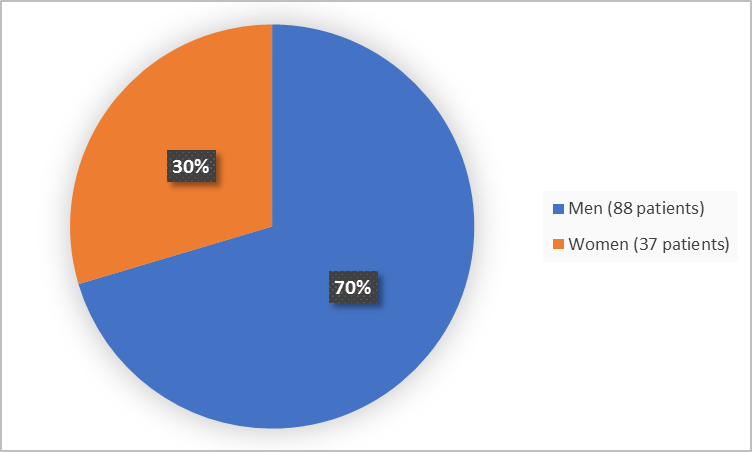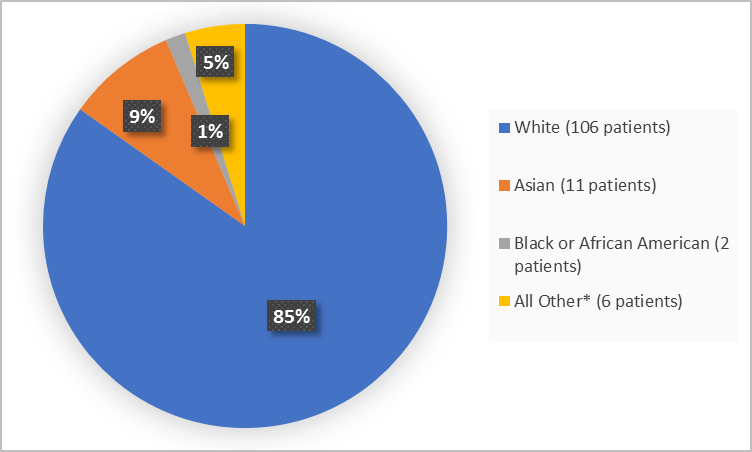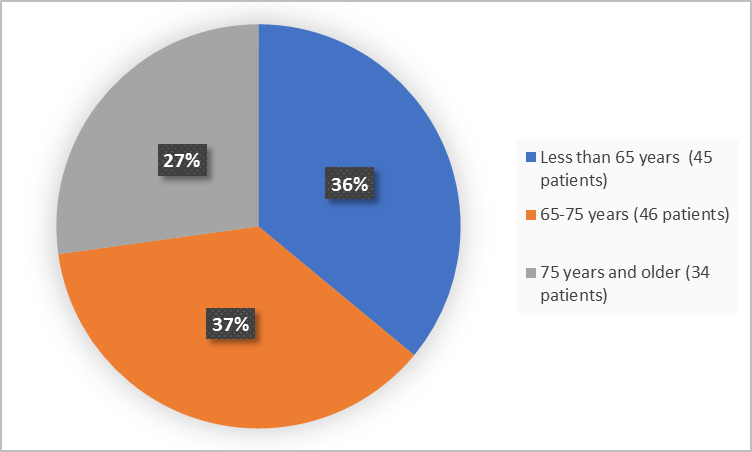Drug Trials Snapshots: PADCEV
HOW TO USE THIS SNAPSHOT
The information provided in Snapshots highlights who participated in the clinical trials that supported the FDA approval of this drug, and whether there were differences among sex, race and age groups. The “MORE INFO” bar shows more detailed, technical content for each section. The Snapshot is intended as one tool for consumers to use when discussing the risks and benefits of the drugs.
LIMITATIONS OF THIS SNAPSHOT:
Do not rely on Snapshots to make decisions regarding medical care. Always speak to your health provider about the risks and benefits of a drug. Refer to the PADCEV Package Insert for complete information.
PADCEV (enfortumab vedotin-ejfv)
PAD-sev
Astellas Pharma
Approval date: December 13, 2019
DRUG TRIALS SNAPSHOT SUMMARY:
What is the drug for?
PADCEV is a drug for the treatment of a type of bladder and urinary tract cancer called urothelial carcinoma. PADCEV may be used in adult patients with urothelial carcinoma:
- whose cancer has spread (locally advanced or metastatic urothelial carcinoma)
- who have received an immunotherapy drugs (called PD-1 and PDL1 inhibitor)
- who have received chemotherapy that contains platinum
How is this drug used?
PADCEV is given by a healthcare professional as an intravenous infusion over 30 minutes on days 1, 8 and 15 of a 28-day treatment cycle.
What are the benefits of this drug?
Forty four percent of 125 patients who received PADCEV experienced complete or partial shrinkage of their tumors which lasted about 7.6 months.
PADCEV was approved under FDA’s accelerated approval program, which provides earlier patient access to a promising new drug while the company continues to conduct clinical trials to confirm that the drug works well.
What are the benefits of this drug (results of trials used to assess efficacy)?
The table below summarizes efficacy results for the clinical trial based on the overall response rate and duration of response (DOR) assessed by blinded independent central review (BICR) using Response Evaluation Criteria In Solid Tumors (RECIST) v1.1.
Table 1. Efficacy Results for Trial 1
|
Endpoint |
PADCEV |
|
Confirmed ORR |
44% |
|
Complete Response Rate (CR) |
12% |
|
Partial Response Rate (PR) |
32% |
|
Median** Duration of Response, months |
7.6 |
NE = not estimable
* Median follow-up duration of 10.2 months **Kaplan-Meier estimate.
† Based on patients (n=55) with a response by BICR.
PADCEV Prescribing Information
Were there any differences in how well the drug worked in clinical trials among sex, race and age?
- Sex: PADCEV worked similarly in men and women.
- Race: The majority of patients were White. The number of patients in other races was limited; therefore, differences in how well PADCEV worked in other races could not be determined.
- Age: PADCEV worked similarly in patents younger and older than 65 years of age.
Were there any differences in how well the drug worked in clinical trials among sex, race, and age groups?
The table below summarizes efficacy results by sex, race, and age group based on the objective response rate (ORR).
Table 2. Subgroup Analysis of Confirmed Objective Response Rate per BICR (Full Analysis Set)
|
|
PADCEV (N = 125) |
|
|
n/N |
ORR (95% CI) |
|
|
Sex |
|
|
|
Men |
40/88 |
45 (34.8, 56.4) |
|
Women |
15/37 |
41 (24.8, 57.9) |
|
Race |
|
|
|
White |
48/106 |
45 (35.6, 55.2) |
|
All Other |
7/19 |
37 (16.3, 61.6) |
|
Age |
|
|
|
< 65 years |
23/45 |
51 (35.8, 66.3) |
|
≥ 65 years |
32/80 |
40 (29.2, 51.6) |
|
< 75 years |
43/91 |
47 (36.7, 58.0) |
|
≥ 75 years |
12/34 |
35 (19.7, 53.5) |
FDA Review
What are the possible side effects?
PADCEV may cause a serious side effects including high blood sugar, damage to peripheral nerves (peripheral neuropathy), eye disorders, skin reactions and infusion site reactions. Other serious side effects include possible harm to an unborn baby.
The most common side effects of PADCEV include rash, fatigue, decreased appetite, hair loss, taste change, peripheral neuropathy, nausea, diarrhea and dry skin.
What are the possible side effects (results of trials used to assess safety)?
The table below summarizes adverse reactions that occurred in the clinical trial.
Table 3. Adverse Reactions Reported in ≥ 15% (Any Grade) or ≥5% (Grade ≥ 3) of Patients
|
Adverse Reaction |
PADCEV |
|
|
All Grades |
Grade 3 |
|
|
Any |
100 |
73 |
|
General disorders and administration site conditions |
||
|
Fatigue* |
56 |
6 |
|
Nervous system disorders |
||
|
Peripheral neuropathy† |
56 |
4 |
|
Dysgeusia |
42 |
0 |
|
Metabolism and nutrition disorders |
||
|
Decreased appetite |
52 |
2 |
|
Skin and subcutaneous tissue disorders |
||
|
Rash‡ |
52 |
13 |
|
Alopecia |
50 |
0 |
|
Dry skin |
26 |
0 |
|
Pruritus§ |
26 |
2 |
|
Gastrointestinal disorders |
||
|
Nausea |
45 |
3 |
|
Diarrhea¶ |
42 |
6 |
|
Vomiting |
18 |
2 |
*Includes: asthenia and fatigue
†Includes: hypoesthesia, gait disturbance, muscular weakness, neuralgia, paresthesia, peripheral motor neuropathy, peripheral sensory neuropathy and peripheral sensorimotor neuropathy.
‡Includes: dermatitis acneiform, dermatitis bullous, dermatitis contact, dermatitis exfoliative, drug eruption, erythema, erythema multiforme, exfoliative rash, palmar-plantar erythrodysesthesia syndrome, photosensitivity reaction, rash, rash erythematous, rash generalized, rash macular, rash maculo-papular, rash papular, rash pustular, rash pruritic, rash vesicular, skin exfoliation, stasis dermatitis, and symmetrical drug-related intertriginous and flexural exanthema (SDRIFE) and urticaria.
§Includes: pruritus and pruritus generalized
¶Includes: colitis, diarrhea and enterocolitis
PADCEV Prescribing Information
Were there any differences in side effects among sex, race and age?
- Sex: The occurrence of side effects was similar in men and women.
- Race: The majority of patients were White. The number of patients in other races was limited; therefore, differences in the occurrence of side effects among other races could not be determined.
- Age: The occurrence of side effects was similar in patents younger and older than 65 years of age.
Were there any differences in side effects of the clinical trials among sex, race, and age groups?
The table below summarize the occurrence of treatment-emergent adverse reactions by demographic subgroups.
Table 4. Grade 3-4 Treatment-Emergent Adverse Events (TEAEs) by Demographic Subgroup
|
|
PADCEV (N = 125) |
|
|
|
|
Any TEAE |
125 (100) |
|
Sex |
|
|
Men |
|
|
Women |
|
|
Race |
|
|
White |
|
|
All Other |
|
|
Age |
|
|
< 65 years |
|
|
≥ 65 years |
|
|
< 75 years |
|
|
≥ 75 years |
|
FDA Review
WHO WAS IN THE STUDIES?
Who participated in the clinical trials?
The FDA approved PADCEV based on evidence from one clinical trial (NCT03219333) of 125 adults with urothelial carcinoma (a type of bladder or urinary tract cancer). The trial was conducted at 40 sites in the United States and Japan.
Figure 1 summarizes how many men and women were in the clinical trial.
Figure 1. Baseline Demographics by Sex
FDA Review
Figure 2 summarizes the percentage of patients by race in the clinical trial.
Figure 2. Baseline Demographics by Race
FDA Review
Figure 3 summarizes the percentage of patients by age in the clinical trial.
Figure 3. Baseline Demographics by Age
FDA Review
The table below summarizes demographics of the patients in the clinical trial.
Table 5. Baseline Demographics
|
Demographic Parameters |
PADACEV |
|
Sex, n (%) |
|
|
Men |
88 (70) |
|
Women |
37 (30) |
|
Race, n (%) |
|
|
Asian |
11 (9) |
|
Black or African American |
2 (2) |
|
White |
106 (85) |
|
Other |
1 (1) |
|
Not Reported |
5 (4) |
|
Age (years) |
|
|
Median |
69 |
|
Age Group, n (%) |
|
|
< 65 years |
45 (36) |
|
≥ 65 years |
80 (64) |
|
< 75 years |
91 (73) |
|
≥ 75 years |
34 (27) |
|
Ethnicity, n (%) |
|
|
Hispanic or Latino |
5 (4) |
|
Not Hispanic or Latino |
118 (94) |
|
Not Reported |
2 (2) |
|
Geographic Region, n (%) |
|
|
United States |
117 (94) |
|
Japan |
8 (6) |
FDA Review
How were the trials designed?
The benefit and side effects of PADCEV were evaluated in one clinical trial. Enrolled patients had bladder and urinary tract cancer that had spread after receiving treatment with PD-1 or PD-L1 inhibitor and platinum-based chemotherapy. All patients received PADCEV infusion over 30 minutes on days 1, 8 and 15 of every 28-day cycle until either the disease worsened, or they developed an unacceptable side effect.
The benefit of PADCEV was evaluated by counting the patients who experienced partial or complete tumor shrinkage.
How were the trials designed?
PADCEV was approved based on an open-label, multicenter clinical trial that enrolled 125 adults 40 to 84 years old with locally advanced or metastatic urothelial cancer who received prior treatment with a PD-1 or PD-L1 inhibitor and platinum-based chemotherapy. Patients received PADCEV 1.25 mg/kg intravenously over 30 minutes on days 1, 8 and 15 of every 28-day cycle until disease progression or unacceptable toxicity.
The primary efficacy outcome measures were confirmed objective response rate and duration of response assessed by BICR using RECIST v1.1.
GLOSSARY
CLINICAL TRIAL: Voluntary research studies conducted in people and designed to answer specific questions about the safety or effectiveness of drugs, vaccines, other therapies, or new ways of using existing treatments.
COMPARATOR: A previously available treatment or placebo used in clinical trials that is compared to the actual drug being tested.
EFFICACY: How well the drug achieves the desired response when it is taken as described in a controlled clinical setting, such as during a clinical trial.
PLACEBO: An inactive substance or “sugar pill” that looks the same as, and is given the same way as, an active drug or treatment being tested. The effects of the active drug or treatment are compared to the effects of the placebo.
SUBGROUP: A subset of the population studied in a clinical trial. Demographic subsets include sex, race, and age groups.



